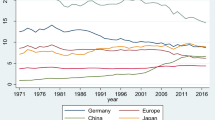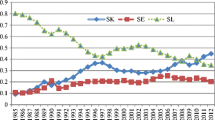Abstract
Despite substantial interest in the role of energy in the economy, the degree of substitutability between energy and other production inputs and the way energy should be included in the production function remain unresolved issues. This study provides industry-level parameter estimates of two-level constant elasticity of substitution (CES) functions that include capital, labor and energy inputs and allow for technological change, for Canada. In contrast to many existing studies, we do not impose prior restrictions on the order of input nesting, and we report the estimates for three possible specifications. We find that a nested production structure, which first combines labor and energy into a composite good that is then combined with capital, fits the Canadian data best, in terms of respecting the restrictions imposed by cost minimization. We also find rather low elasticities of substitution between capital and labor, and limited evidence of exogenous technological change.
Similar content being viewed by others
Notes
Empirical effects of non-competitive input markets are difficult to estimate, since this requires the joint modelling and estimation of factor supply functions. Similar to other studies in the literature (e.g. Berndt and Wood 1975; Christensen, Jorgenson, and Lau 1971; León-Ledesma et al. 2010), we treat input prices as exogenous.
See Allen and Diewert (1981) for discussions on the properties of Törnqvist indices.
References
Allen, R. C., & Diewert, E. (1981). Direct versus implicit superlative index number formulae. The Review of Economics and Statistics, 63(3), 430–435.
Antràs, P. (2004). Is the U.S. aggregate production function Cobb-Douglas? New estimates of the elasticity of substitution. The B.E. Journal of Macroeconomics, De Gruyter, 4(1), 1–36.
Baily, M., Hulten, C. and Campbell, D. (1992). Productivity dynamics in manufacturing plants. Brookings Papers on Economic Activity, 187–249.
Beausejour, L., Lenjosek, G., & Smart, M. (1995). A CGE approach to modeling carbon dioxide emissions control in Canada and the United States. World Economy, 18(3), 457–489.
Beckman, J., Hertel, T. (2010). Why previous estimates of the cost of climate mitigation are likely too low. GTAP Working Paper 54 (version 3).
Berndt, E. R., & Wood, D. (1975). Technology, prices and the derived demand for energy. Review of Economics and Statistics, 56(3), 259–268.
Bodenstein, M., Erceg, C. J., & Guerrieri, L. (2011). Oil shocks and external adjustment. Journal of International Economics, 83(2), 168–184.
Bohringer, C., & Rutherford, T. F. (1997). Carbon taxes with exemptions in an open economy: a general equilibrium analysis of the German tax initiative. Journal of Environmental Economics and Management, 32(2), 189–203.
Bosetti, V., Carraro, C., Galeotti, M., Massetti, E., & Tavoni, M. (2006). A world induced technical change hybrid model. Energy Journal, Special Issue, 2, 13–38.
Burniaux, J.-M., & Truong, T. (2002). GTAP-E: an energy-environmental version of the GTAP model. GTAP Technical Paper, 16, 1–31.
Carlstrom, C. T., & Fuerst, T. S. (2006). Oil prices, monetary policy, and counterfactual experiments. Journal of Money, Credit and Banking, 38(7), 1945–1958.
Chang, K.-P. (1994). Capital-energy substitution and the multi-level production function. Energy Economics, 16(1), 22–26.
Christensen, L., Jorgenson, D., & Lau, L. (1971). Conjugate duality and the transcendental logarithmic utility function. Econometrica, 39(4), 255–256.
David, P., & van de Klundert, T. (1965). Biased efficiency growth and capital-labor substitution in the U.S., 1899–1960. American Economic Review, 55(3), 357–394.
Finn, M. G. (2000). Perfect competition and the effects of energy price increases on economic activity. Journal of Money, Credit and Banking, 32(3), 400–416.
Jacoby, H. D., Reilly, J. M., McFarland, J. R., & Paltsev, S. (2006). Technology and technical change in the MIT EPPA model. Energy Economics, 28(5–6), 610–631.
Kemfert, C. (1998). Estimated substitution elasticities of a nested CES production function approach for Germany. Energy Economics, 20(3), 249–264.
Kim, I.-M., & Loungani, P. (1992). The role of energy in real business cycle models. Journal of Monetary Economics, 29(2), 173–189.
Klump, R., & de la Grandville, O. (2000). Economic growth and the elasticity of substitution: two theorems and some suggestions. American Economic Review, 90(1), 282–291.
Klump, R., McAdam, P., & Wilman, A. (2007). The long-term success of the neoclassical growth model. Oxford Review of Economic Policy, 23(1), 94–114.
Lecca, P., Swales, K., & Turner, K. (2011). An investigation of issues relating to where energy should enter the production function. Economic Modelling, 28(6), 2832–2841.
León-Ledesma, M. A., McAdam, P., & Willman, A. (2010). Identifying the elasticity of substitution with biased technical change. American Economic Review, 100(4), 1330–1357.
Popp, D. (2004). ENTICE: endogenous technical change in the DICE model of global warming. Journal of Environmental Economics and Management, 48(1), 742–768.
Prywes, M. (1986). A nested CES approach to capital-energy substitution. Energy Economics, 8(1), 22–28.
Sato, K. (1967). A two-level constant-elasticity-of-substitution production function. Review of Economic Studies, 34, 201–218.
Schubert, S., & Turnovsky, S. (2011). The impact of energy prices on growth and welfare in a developing open economy. Open Economies Review, 22(3), 365–386.
van der Werf, E. (2008). Production functions for climate policy modeling: an empirical analysis. Energy Economics, 30(6), 2964–2979.
Vinals, J. M. (1984). Energy-capital substitution, wage flexibility and aggregate output supply. European Economic Review, 26(1–2), 229–245.
Author information
Authors and Affiliations
Corresponding author
Rights and permissions
About this article
Cite this article
Dissou, Y., Karnizova, L. & Sun, Q. Industry-level Econometric Estimates of Energy-Capital-Labor Substitution with a Nested CES Production Function. Atl Econ J 43, 107–121 (2015). https://doi.org/10.1007/s11293-014-9443-1
Published:
Issue Date:
DOI: https://doi.org/10.1007/s11293-014-9443-1




